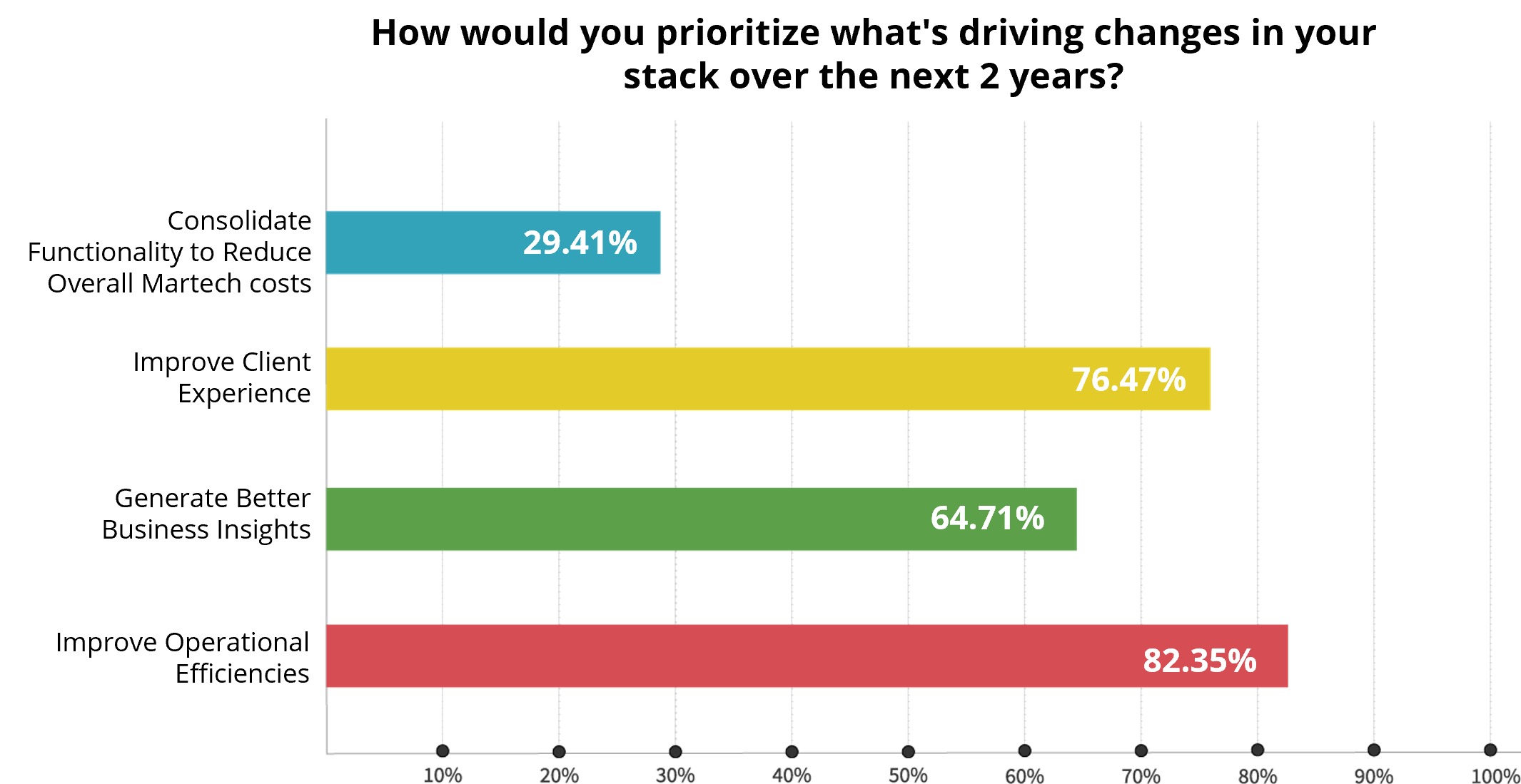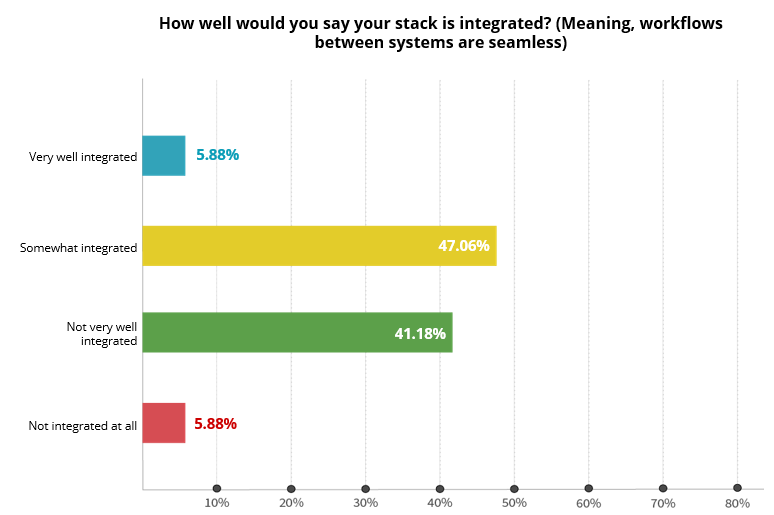How CDPs Create Operational Efficiencies for Asset Managers
How CDPs Create Operational Efficiencies
and Drive Growth for Asset Managers
What challenges do asset managers find themselves facing today?
As the business landscape has been reshaped coming out of the COVID-19 pandemic, asset managers find themselves facing two unique challenges today; reduced in-person engagement, and a continued need for operational efficiency.
First, the pandemic significantly reduced the level of in-person engagement for business development which has always been a critical tool in gaining trust, building rapport, and maintaining a personalized customer experience. While some of the interpersonal engagement has returned in late-2022, it’s clear that the use of advanced technologies must still be counted on to replace a good deal of in-person interactions from the past. This has led to advisors demanding new and unique ways to have relevant interactions with their customers. As a result, the industry has built out the infrastructure to engage the way advisors prefer. Asset Managers must still bring together the content needed for the level of relevance in the advisor experience that is expected. At the core of these experiences and interactions is data.
Operational efficiency is no-longer simply a buzzword, it’s a guiding ethos in the asset management community today. According to a survey by Hewitt / SynthesisTechnologies / Sondhelm Partners nearly 83% of asset managers surveyed noted that improvement of operational efficiencies was the single most important driver of change in their stack over the coming two years. This is closely followed by nearly 77% who note that improving the client experience was the driver. Looking at these two topics hand in hand, it’s clear that asset managers need to have access to high-quality, real-time data including semi and unstructured data to meet these goals.

In the same survey, only 6% of asset managers surveyed noted that their current stack is very well integrated. Considering that this integration is critical to both operational efficiency as well as the ability to improve the advisor experience, it’s clear that there is work to be done. When asked which elements of their stack aren’t integrated currently but should be, CRM systems (53%) and Marketing Automation (40%) stood out quite high, underscoring the opportunity here.

What’s the prize to be won by the successful asset managers who quickly capitalize on digital data? Simply put – profitable, organic growth. Data is a key foundational element to that, and the seamless integration of tools to unlock the power of that data is an organizational requirement.
It’s all about the data
The lack of proper data integration is a major barrier to achieving operational efficiency and delivering a customer experience that will acquire and retain advisors. If advisors are not able to derive insights from calls, sales data, website behaviors, SMS messages, and other forms of engagement – they won’t be able to meet their sales performance goals. This critical data is both first-party and third-party data, and additionally semi and unstructured data needs to be available in one location for effective engagement.
This is where a Customer Data Platform (CDP) can come into place and play a critical role – having data in one place drives towards that critical goal of operational efficiency. Once the data comes together in a CDP, artificial intelligence (AI) can be used to determine tendencies of customers looking at their past transactions and give clues to the advisor when the ideal time is to make contact. Machine learning (ML) can be leveraged to create personas to understand customers, their return expectations, and their readiness for change and investment decisions.
CDPs additionally can play a role to reduce manual interventions with data and limit the need for complex analysis done taking hours of valuable marketers’ time. The improved CX of a CDP allows asset managers to use data to target, predict, and personalize communications to their advisor such as when to make contact or other events that are most relevant.

What is a CDP
CDPs are marketing technology based around a centralized data hub with the ability to ingest, integrate, manage, and deliver customer data to other marketing technology solutions within an organization with the goal of personalization of the customer experience. CDPs bring together all forms of customer data to create a unified customer profile. This view can be used to align all business and marketing efforts around a single source of customer truth. Bringing together consumer behavior data, demographic data, as well as transactional data, CDPs are able to track and analyze your advisors’ interactions with your organization. Earlier in the year, Munvo referred to 2022 as the ‘Year of the CDP‘ noting that CDPs deliver a unified spectrum of customer information and empower marketers in a self-serve ecosystem.
CDPs have several core capabilities to be RealCDP™ certified according to the CDP Institute definition of a CDP – “packaged software that creates a persistent, unified, customer data that is accessible to other systems.” To qualify, they must:
- ingest data from any source
- capture full detail of ingested data
- store ingested data indefinitely (subject to privacy constraints)
- create unified profiles of identified individuals
- share data with any system that needs it
- respond in real time to new data and to profile requests
What types of CDPs exist?
The CDP Institute groups CDP vendors into four categories based on their functionality.
Data CDPs
These systems gather customer data from source systems, link data to customer identities, and store the results in a database available to external systems. This is the minimum set of functions required to meet the definition of a CDP. In practice, these systems also can extract audience segments and send them to external systems. Systems in this category often employ specialized technologies for data management and access. Some began as tag management or Web analytics systems and retain considerable legacy business in those areas.
Analytics CDPs
These systems provide data assembly plus analytical applications. The applications always include customer segmentation and sometimes extend to machine learning, predictive modeling, revenue attribution, and journey mapping. These systems often automate the distribution of data to other systems.
Campaign CDPs
These systems provide data assembly, analytics, and customer treatments. What distinguishes them from segmentation is they can specify different treatments for different individuals within a segment. Treatments may be personalized messages, outbound marketing campaigns, real time interactions, or product or content recommendations. They often include orchestrating customer treatments across channels.
Delivery CDPs
These systems provide data assembly, analytics, customer treatments, and message delivery. Delivery may be through email, Web site, mobile apps, CRM, advertising, or several of these. Products in this category often started as delivery systems and added CDP functions later.
Ready to get started?
How do you know if a CDP is right for you, and if so, which type? First, you must identify the specific use cases which you are trying to solve for, and then match those use cases against the CDP capabilities offered.
Munvo can help you determine if a CDP is right for your needs and goals. By first taking stock of your existing MarTech stack, as well as your goals and existing roadmap, we can partner with you to identify critical use cases and match that against the appropriate CDP offerings. Leveraging proven frameworks and templates from our work in MarTech since 2005, we enable quick time to value.
If you’re ready to investigate the value of a CDP for your business in 2022, book a free consultation.
Authors

Marianne Hewitt
Principal at The Growth Strategy Group
Marianne Hewitt, Principal at The Growth Strategy Group, is a recognized thought leader in marketing trends and an implementer of technology powered marketing programs, practices and organizations. Her career includes Fortune 100 manufacturing, insurance and high tech positions in marketing, sales and IT. Ms. Hewitt is a member of and blogs for the CDP Institute.

Alexis Romero
Sr. Director of Data & Analytics at Munvo
Alexis Romero, Sr. Director of Data & Analytics at Munvo is a data enthusiast with over 10 years industry experience. Throughout his career at Munvo he’s worked with Fortune 500 companies to develop architecture for digital ecosystems for MarTech and AdTech, as well as BI, analytics, and CRM implementations with a strategic focus on client success.
Sales Inquiries + 1 (514) 223 3648
General Inquiries + 1 (514) 392 9822
sales@munvo.com
© 2024 Munvo is a trademark of Munvo Solutions Inc.



